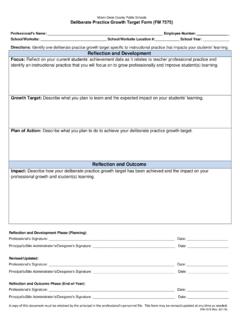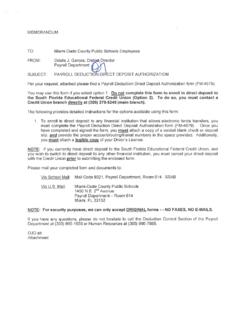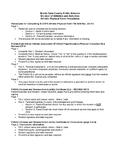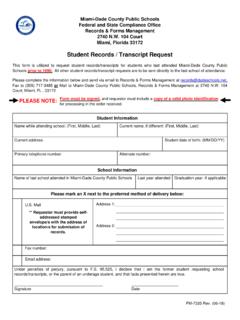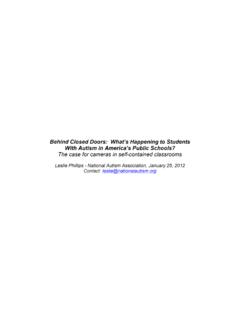Transcription of Behavior Intervention Plan (BIP) – Part 1 Problem …
1 Student Name: _____ ID#: _____ DOB: _____ School: _____ Grade: _____ Date: _____ 1 Behavior Intervention plan (BIP) part 1 Problem Behavior Summary and Goal Statements Step 1: Problem Behavior Summary Statement: From the information provided from the Student Profile and considering all relevant data collected, identify ONE Behavior to be targeted for Intervention . Write a brief summary statement that includes what set off the Behavior , the Behavior itself and what the student gains from the Problem Behavior .
2 Setting Event Antecedent (A) Problem Behavior (B) Maintaining Consequence (C) The Function of the Behavior has been determined to be: Check one Step 2: Replacement Behavior : What Behavior will the student perform in place of the Problem Behavior ? Complete the Goal Statement considering the above information Setting Event Antecedent (A) Replacement Behavior (RB) Reinforcing Consequence (C) 2.
3 The student ..In order Especially 3. Especially 2..The student ..In order To Get To Avoid/Escape FM-6287 Rev. (04-12)Student Name: _____ ID#: _____ DOB: _____ School: _____ Grade: _____ Date: _____ 2 Behavior Intervention plan part 2 Problem Behavior : Definition of Problem Behavior : Explain in details below: Examples: using profanity around younger students Example: The use of language which is socially unacceptable for children to use around adults. Replacement Behavior : Purpose(s) of Replacement Behavior : Example: Improve communication skills ask for help Example: To teach student to recognize anxiety or anger/frustration and get help to vent appropriately (cool down time, removing self from situation, speaking with staff/peers).
4 Anticipated Behavior Changes include a description in measurable and observable terms of the Behavior change(s) expected by those implementing the BIP Other: Example: Student will recognize when he is becoming angry and will seek the assistance of an adult rather than using profanity to gain attention FM-6287 Rev. (04-12)Student Name: _____ ID#: _____ DOB: _____ School: _____ Grade: _____ Date: _____ 3 Behavior Intervention plan part 3a Directions: Check one or two appropriate Intervention (s) in each of the 3 categories.
5 Ensure that the chosen Intervention (s) match the function of the Problem Behavior . Proactive interventions Q What environmental adjustments and/or teacher behaviors will be attempted to make the Problem Behavior less likely to occur? P-1 Preferential seating P-2 Encourage positive peer connections P-3 Contract for grades P-4 Daily/Weekly progress report P-5 Establish teacher/parent communication system P-6 Frequent monitoring and redirection by teacher P-7 Establish a personal connection with student P-8 Choice making P-9 Curricular adjustments P-10 Encourage participation in extracurricular activities P-11 Provide guidance prior to independent work P-12 Follow-up to ensure student
6 Understanding of task/request P-13 Schedule adjustment P-14 Give student an opportunity to mentor/tutor a peer P-15 Increase frequency of task related recognition P-16 Allow student to use quiet time/space P-17 Identify appropriate settings for Behavior (s) P-18 Visual schedule P-19 Environmental changes (lighting, furniture, sound sources) P-20 Other: A Consider adjustments to when and where the Problem Behavior is likely to occur; in addition, consider adjustments to subject/activity or the people present when the Problem Behavior is most likely to occur.
7 Describe interventions in detail: FM-6287 Rev. (04-12)Student Name: _____ ID#: _____ DOB: _____ School: _____ Grade: _____ Date: _____ 4 Behavior Intervention plan part 3b Educative interventions Q What new behaviors/strategies will be taught to replace the problematic Behavior ? E-1 Teach rules/expectations prior to activity E-2 Have student repeat rules/expectations prior to transitions E-3 Develop monitoring checklist for teacher/student use E-4 Teach and model appropriate communication skills E-5 Provide opportunities to practice communication and social skills E-6 Teach coping skills (asking for time out, relaxation when frustrated) E-7 Teach positive self-talk E-8 Remediation in specific academic areas E-9 Perform Task Analysis.
8 Break down and concretize steps for success E-10 Use student's personal interests to increase motivation ( , If a student likes fishing, reading tasks can be related) E-11 Teach alternative behaviors for sensory feedback E-12 Teach anger management/ Problem -solving skills E-13 Teach behavioral self-control E-14 Social stories/Comic book conversations E-15 Other: Functional A What skills will the student need to be taught in order to successfully demonstrate the replacement Behavior ? When? Who will teach? How will skills be taught/monitored across settings?
9 Describe interventions in detail: FM-6287 Rev. (04-12)Student Name: _____ ID#: _____ DOB: _____ School: _____ Grade: _____ Date: _____ 5 Behavior Intervention plan part 3c Functional interventions Q How will consequences be managed to ensure the student receives reinforcement for the replacement Behavior ? F-1 Use preferred activities as reinforcer F-2 Personally greet the student upon arrival to class F-3 Spend individual time with the student F-4 Increase frequency of positive reinforcement F-5 Use tangible and/or non-tangible rewards F-6 Develop a written Behavior contract F-7 Assign classroom responsibility that allows student recognition F-8 Chart daily successes and review often with student F-9 Recognize small steps approximating the desired Behavior F-10 Ignore undesirable behaviors F-11 Reward competing behaviors F-12 Student self-monitoring
10 Of progress F-13 Acknowledge use of replacement behaviors F-14 Establish logical sequences and inform students in advance F-15 Give encouragement for effort to display appropriate Behavior F-16 Use of positive referrals F-17 Use classroom reinforcers for individual student accomplishments F-18 Call home to share news of student effort/success F-19 Use school-wide vehicles for recognition F-20 Other: A What will be done to increase the occurrence of the replacement Behavior ? Describe interventions in detail: FM-6287 Rev.
